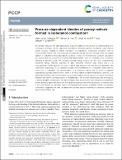| dc.contributor.author | Goldman, Mark Jacob | |
| dc.contributor.author | Yee, Nathan Wa-Wai | |
| dc.contributor.author | Kroll, Jesse | |
| dc.contributor.author | Green Jr, William H | |
| dc.date.accessioned | 2020-10-06T22:19:06Z | |
| dc.date.available | 2020-10-06T22:19:06Z | |
| dc.date.issued | 2020-08 | |
| dc.date.submitted | 2020-05 | |
| dc.identifier.issn | 1463-9084 | |
| dc.identifier.issn | 1463-9076 | |
| dc.identifier.uri | https://hdl.handle.net/1721.1/127820 | |
| dc.description.abstract | Bio-derived isobutanol has been approved as a gasoline additive in the US, but our understanding of its combustion chemistry still has significant uncertainties. Detailed quantum calculations could improve model accuracy leading to better estimation of isobutanol's combustion properties and its environmental impacts. This work examines 47 molecules and 38 reactions involved in the first oxygen addition to isobutanol's three alkyl radicals located α, β, and γ to the hydroxide. Quantum calculations are mostly done at CCSD(T)-F12/cc-pVTZ-F12//B3LYP/CBSB7, with 1-D hindered rotor corrections obtained at B3LYP/6-31G(d). The resulting potential energy surfaces are the most comprehensive isobutanol peroxy networks published to date. Canonical transition state theory and a 1-D microcanonical master equation are used to derive high-pressure-limit and pressure-dependent rate coefficients, respectively. At all conditions studied, the recombination of γ-isobutanol radical with O₂ forms HO₂ + isobutanal. The recombination of β-isobutanol radical with O₂ forms a stabilized hydroperoxy alkyl radical below 400 K, water + an alkoxy radical at higher temperatures, and HO₂ + an alkene above 1200 K. The recombination of β-isobutanol radical with O₂ results in a mixture of products between 700–1100 K, forming acetone + formaldehyde + OH at lower temperatures and forming HO₂ + alkenes at higher temperatures. The barrier heights, high-pressure-limit rates, and pressure-dependent kinetics generally agree with the results from previous quantum chemistry calculations. Six reaction rates in this work deviate by over three orders of magnitude from kinetics in detailed models of isobutanol combustion, suggesting the rates calculated here can help improve modeling of isobutanol combustion and its environmental fate. | en_US |
| dc.description.sponsorship | National Science Foundation (Grants 1709993, 1122374) | en_US |
| dc.language.iso | en | |
| dc.publisher | Royal Society of Chemistry (RSC) | en_US |
| dc.relation.isversionof | http://dx.doi.org/10.1039/d0cp02872j | en_US |
| dc.rights | Creative Commons Attribution 3.0 unported license | en_US |
| dc.rights.uri | https://creativecommons.org/licenses/by/3.0/ | en_US |
| dc.source | Royal Society of Chemistry (RSC) | en_US |
| dc.title | Pressure-dependent kinetics of peroxy radicals formed in isobutanol combustion | en_US |
| dc.type | Article | en_US |
| dc.identifier.citation | Goldman, Mark Jacob et al. "Pressure-dependent kinetics of peroxy radicals formed in isobutanol combustion." Physical Chemistry Chemical Physics (August 2020): 19802-19815 | en_US |
| dc.contributor.department | Massachusetts Institute of Technology. Department of Civil and Environmental Engineering | en_US |
| dc.contributor.department | Massachusetts Institute of Technology. Department of Chemical Engineering | en_US |
| dc.relation.journal | Physical Chemistry Chemical Physics | en_US |
| dc.eprint.version | Final published version | en_US |
| dc.type.uri | http://purl.org/eprint/type/JournalArticle | en_US |
| eprint.status | http://purl.org/eprint/status/PeerReviewed | en_US |
| dc.date.updated | 2020-09-18T17:27:55Z | |
| dspace.date.submission | 2020-09-18T17:27:58Z | |
| mit.license | PUBLISHER_CC | |
| mit.metadata.status | Complete | |
